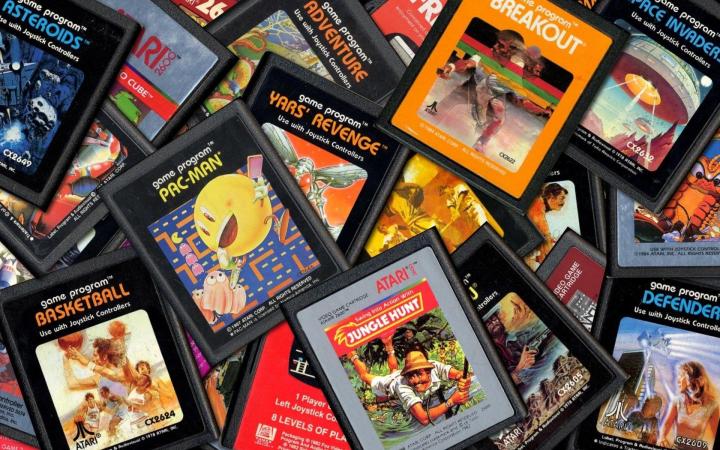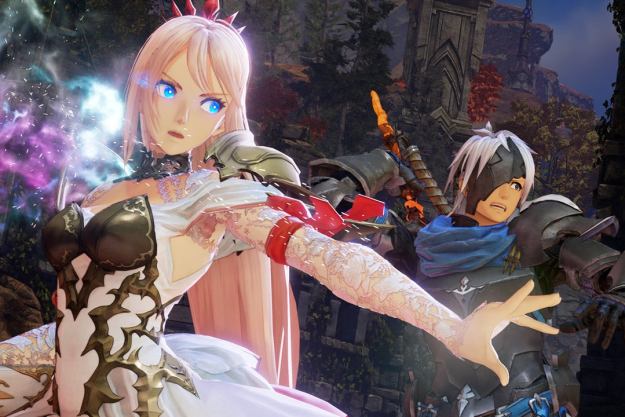Even though I was a child of the ’90s who grew up with a Sega Genesis, my favorite console was my mother’s hand-me-down Atari 2600. It was the one console I kept hooked up to the TV in my bedroom, while my PlayStation was in the living room. Playing a game like Pitfall! was a special experience. It was almost a ritual, as I’d sit on the floor directly in front of my CRT TV, slot in a massive cartridge, and hold the joystick controller like I was giving an acceptance speech for an Oscar.
That experience isn’t easily replicated decades later. I can head to any emulation site and play Pitfall!, but it isn’t the same. It lacks the physicality of holding an old joystick or the mystique of carefully studying the key art of the cartridge before I slot it in. It’s easy to port a game; it’s much harder to preserve what it felt like to play it when it first came out.
For Atari, that challenge is paramount. The iconic game maker is in the midst of a transformation led by CEO Wade Rosen. With that pivot, Atari is returning to its roots by putting an emphasis on its history. Classics like Asteroids and Breakout are receiving modern makeovers, lost games are making a comeback, and Atari is even producing new cartridges that actually work on a 2600 console.
The strategy isn’t a Hail Mary nostalgia play. In speaking with current Atari leadership, the company is trying to tackle a complicated preservation question that few game companies seem to be concerned about: How do you preserve the legacy of video games?
Physical history
When players talk about game preservation, the conversation question largely revolves around porting games to other systems. It’s been a hot topic in recent years for a variety of reasons, from Nintendo shuttering its old eShops to Sony struggling to bring native ports of PS3 games to PS5. Making old games playable is important, but it’s only half the battle.

Rosen took the CEO helm at Atari in April 2021. A millennial, Rosen grew up with consoles like the Super Nintendo more than the Atari 2600, but remembers playing the console’s games in a PC bundle. While he was still able to enjoy games like Tempest in that format, he believes that preservation is more complicated than simply churning out ports of old titles.
“If you want to play an old PC game, there’s a good chance you can access it and have it,” Rosen tells Digital Trends. “If you want to play older console releases, there’s really no equivalent. There’s no central place that is going to not just let you see the game, but look at the box art and look at the all manuals that came with it. In the same way that we have outlets and platforms that are great for PC gaming, I think there needs to be something that’s the equivalent for retro console gaming. I don’t think that means just porting it to modern consoles.”
“When we bring some of these titles back, we want to bring them back how you remember them.”
The physicality of older games creates challenges that aren’t easily resolved. Anyone who’s played a Nintendo 64 game via Switch Online knows how awkward a game like Winback can feel without the trident controller it was designed around. Similarly, pixel art looks entirely different on a modern TV than it did on an old CRT. While my Atari 2600 ritual may sound purely symbolic, playing Pitfall! on a 4K flat screen with an Xbox Wireless Controller is a fundamentally different experience.
“Does it feel the same playing Radiant Silver Gun on Sega Saturn and on the Xbox 360?” Rosen asks. “There’s pros and cons of both, but there’s something kind of beautiful about sitting down with that little black box, playing with that specific Saturn controller, and seeing it run on a CRT television.”

Atari has tried to solve that by keeping physical objects in its product line alongside digital releases. The Atari XP initiative, for instance, brings rare and unreleased Atari games like Yars’ Revenge to players the way they were meant to be played originally: As fully functional 2600 cartridges that come with instruction manuals. Is that practical? Probably not for most players, which is likely why the bundles include a digital download of the games too. But that commitment to saving the experience goes beyond what companies like Nintendo are doing to bring classics to modern audiences.
Old is new, new is old
While physical products play a large role in Atari’s strategy, its approach to games themselves is just as important. In a chat during this year’s Game Developers Conference, David Lowey, Atari senior director of marketing and sales, explained that the company’s brand was previously “out of balance.” The pop culture symbol of Atari remained strong, but its relevance as a game publisher had fallen off. Rosen has been instrumental in restoring the company’s focus, pivoting from free-to-play mobile experiences back to premium console and PC games.
That strategy starts with Atari’s Recharged line, which acts as a bridge between old and new. The series takes iconic Atari games and gives them light modern touches. In something like Breakout: Recharged, players get the classic blockbusting game with new features like leaderboards and power-ups. They’re new, but still feel incredibly familiar — and that’s an intentional design decision.
“When we bring some of these titles back, we want to bring them back how you remember them,” Lowey tells Digital Trends. “Which means that we’re probably going to sweeten the controls and make it really playable without messing with the core gameplay.”

It’s a difficult needle to thread when it comes to video games. On one hand, I want Pitfall! to be brought to modern machines purely untouched, trapped in amber. But that version of the game wouldn’t have the same impact in 2022 as it did when it launched. If I tried to show it to a friend and explain how thrilling it felt at the time, they’d probably laugh at me. Atari is aware of that fundamental challenge to its legacy and has tweaked its games accordingly to preserve the spirit of old games, rather than every little nuance.
“Adventure, for me, was the first thing I played that had a secret room,” Lowey said. “The sense of exploration … to me, it was an amazing game despite how simple it was. So if we’re going to work with somebody on Adventure, it has to bring that feeling back up. And we’re going to release Adventure on a 2600 cartridge. It’s going to be an original game, but we’re looking for the right partner to work on that IP in a way that it’s going to be a totally new game, but it’s going to bring back that feeling.”
Accessing the past
There’s an entire other layer to the preservation debate that tends to go under the radar. Much of the conversation centers around games themselves, but Atari is just as focused as salvaging information about how those games were actually made.
“There’s a preservation issue when it comes to our brand,” Lowey says. “The company’s gone through a couple iterations. A lot of the historical knowledge of the company and what it did isn’t inside the brand. So when we bring titles back, there’s an opportunity for us to have that conversation. Reach out to the community, bring their stories out.”
“Right now, it’s tough to even know where to go when you want to work with these things.”
Rosen is no stranger to hunting down information on old games. He previously worked at Ziggurat, a company built around preserving the legacy of games. In that role, Rosen saw just how hard it can be to even figure out who holds the rights to games, as things like credits are often lost to time. He notes that he previously tried to get his hands on the classic Backyard Sports series, but kept hitting dead ends when trying to track down the IP holder.
That frustration is part of the reason that Atari recently acquired MobyGames, a site known for exhaustively cataloging details on games and the teams that made them.
“People who want to work with retro titles often don’t know where to go,” Rosen says. “I experienced this with Ziggurat. There were games we wanted to work with or companies we wanted to reach out to and we had no idea where to look. It started and stopped with MobyGames. As a central repository for where people could go to not just find out about old games, but potentially reach out to the IP holders … Right now, it’s tough to even know where to go when you want to work with these things.”

If the gaming industry’s lack of historical knowledge sounds infuriating, there’s a somewhat reasonable explanation for it. Video games have evolved quickly over the past few decades, with developers constantly pushing the limits of technology. In the moment, that rapid change is part of what makes video games exciting. It’s easy to get distracted by the shiny new thing and forget about last year’s model as it sinks into obscurity. Rosen is more understanding than some about the current state of preservation, but sees opportunity for Atari as a result of it.
“With the industry at large, preservation hasn’t really been important. Now, we’re reaching a level of sentimentality around it that makes it important,” Rosen says. “I wouldn’t say that the industry is failing, but the industry was constantly about looking forward. When the Super Nintendo came out, people weren’t like ‘We need to preserve the 2600 and NES.’ They were these natural iterations. But what we’re seeing today is reflective of what people want in their lives. We want simplicity, we want less noise. Where we are today as a society is recognizing that there was a lot of beauty in what existed before.”
Atari isn’t just dabbling in its past for nostalgia’s sake. It’s a purposeful, multipronged approach that seeks to keep gaming’s most fundamental building block from disappearing. Lowey says that the company is thinking of its next 50 years just as much as its first 50. While the company is invested in preserving its history, it wants to do so as a means of pushing the industry forward.
“When I talk about the past, it’s usually because I want to make a point about the future,” says Lowey.
Editors' Recommendations
- A Redditor ‘didn’t know’ about the Steam Deck, so they built their own
- Square Enix just set a new bar for video game demos with its latest RPG
- I’m secretly hoping that the leaked all-white Xbox Series X isn’t real
- Baldur’s Gate 3 isn’t getting DLC or a sequel from Larian, and that’s OK
- World of Goo 2 might just be the Nintendo Switch’s next must-own co-op game




